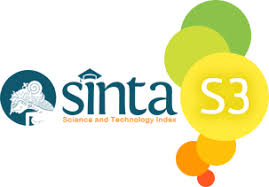Tren Gaya Hidup Sehat dan Saluran Komunikasi Pelaku Pola Makan Food Combining
 Abstract views: 3026
,
Abstract views: 3026
,
 PDF downloads: 2857
PDF downloads: 2857
Abstract
This research is concerned with the dissemination of information about healthy lifestyle trends that have been popular in Indonesia through Food Combining as a process of diffusion of innovation in health communication. By applying the diet Food Combining is expected that the human body will grow healthier, full of energy, and free from disease. Problems to be studied are about: 1) What motivates the perpetrators of diet combining diet in applying a healthy lifestyle? and 2) What channels of communication are used to find information related to diet combining? as well as 3) How to interact with the community of other food combining actors across Indonesia?
This research uses qualitative methodology, with the object of research is various media information (print media, social media, and electronic media) along with all communication channel used by food combiner (member or community) Food Combining Indonesia with approach of Innovation Diffusion Theory.
The results concluded that food combining is a new trend of healthy lifestyle of today that is motivated physiological needs which is the hierarchy of the most basic human needs to survive, including keeping the body fit and healthy and free from all kinds of diseases. While the communication channels in the process of diffusion of innovation in order to disseminate information and knowledge about healthy food lifestyle trends is done through social media with two-stage communication method which is a combination between the use of mass media channels and interpersonal channels by interacting through: personal contact, chatting applications, social media group, and gathering.
Keywords: communication channels, innovation diffusion, health communication, healthy lifestyle, food combining
References
Denzin, N. K. and Lincoln., Yvonna S. (2009). Handbook of Qualitative Research. Yogyakarta: Pustaka Pelajar.
Gunawan, A. W. (2015). Food Combining: Pola Makan untuk Langsing dan Sehat. Jakarta: Gramedia Pustaka Utama.
Handoko, H. T, Dr.MBA dan Reksohadiprodjo, S, Dr. M.Com. 1996. Organisasi Perusahaan (edisi kedua). Yogyakarta: BPFE.
Moleong, L. J. (2004). Metode Penelitian Kualitatif (Cetakan ke-18). Bandung: PT. Remaja Rosda karya.
Mulyana, D. (2002). Metode Penelitian Kualitatif Paradigma Baru Ilmu Komunikasi dan Ilmu Sosial Lainnya. Bandung: PT. Remaja Rosda karya.
Susilo, D. (2017). Etnometodologi Sebagai Pendekatan Baru dalam Kajian Ilmu Komunikasi. Jurnal Studi Komunikasi (Indonesian Journal of Communications Studies), 1(1).
Copyright (c) 2017 Jurnal Komunikasi Profesional

This work is licensed under a Creative Commons Attribution-ShareAlike 4.0 International License.

Jurnal Komunikasi Profesional is licensed under a Creative Commons Attribution-ShareAlike 4.0 International License.
1. Proposed Policy for Journals That Offer Open Access
Authors who publish with this journal agree to the following terms:
- Authors retain copyright and grant the journal right of first publication with the work simultaneously licensed under a Creative Commons Attribution License that allows others to share the work with an acknowledgment of the work's authorship and initial publication in this journal.
- Authors are able to enter into separate, additional contractual arrangements for the non-exclusive distribution of the journal's published version of the work (e.g., post it to an institutional repository or publish it in a book), with an acknowledgement of its initial publication in this journal.
- Authors are permitted and encouraged to post their work online (e.g., in institutional repositories or on their website) prior to and during the submission process, as it can lead to productive exchanges, as well as earlier and greater citation of published work (See The Effect of Open Access).
2. Proposed Policy for Journals That Offer Delayed Open Access
Authors who publish with this journal agree to the following terms:
- Authors retain copyright and grant the journal right of first publication, with the work [SPECIFY PERIOD OF TIME] after publication simultaneously licensed under a Creative Commons Attribution License that allows others to share the work with an acknowledgement of the work's authorship and initial publication in this journal.
- Authors are able to enter into separate, additional contractual arrangements for the non-exclusive distribution of the journal's published version of the work (e.g., post it to an institutional repository or publish it in a book), with an acknowledgement of its initial publication in this journal.
- Authors are permitted and encouraged to post their work online (e.g., in institutional repositories or on their website) prior to and during the submission process, as it can lead to productive exchanges, as well as earlier and greater citation of published work (See The Effect of Open Access).



